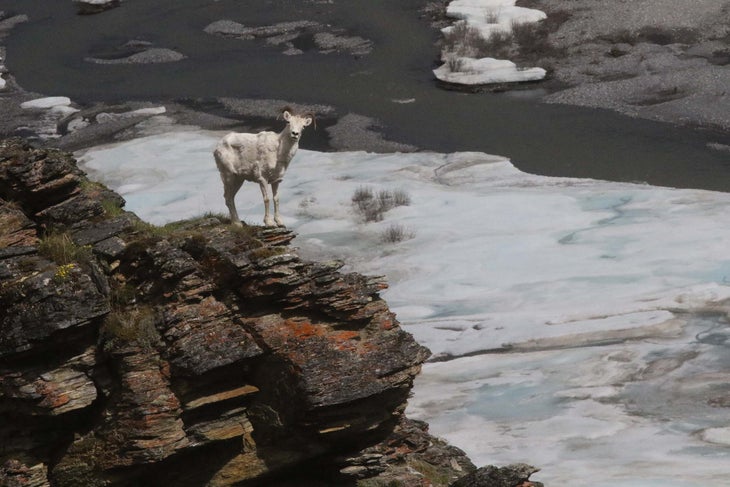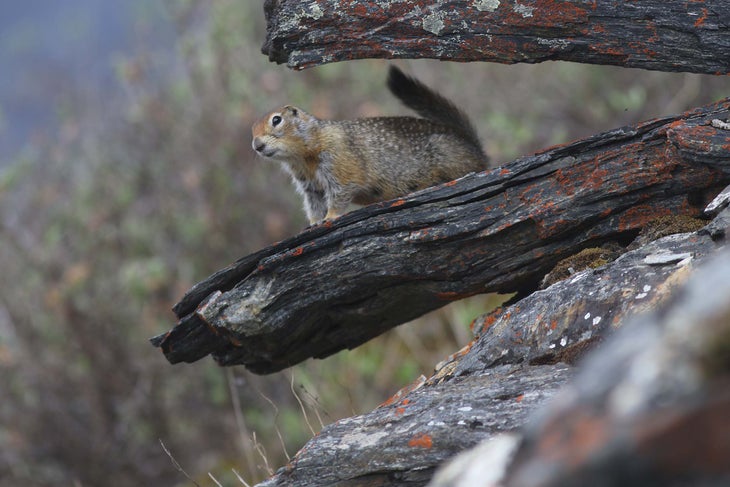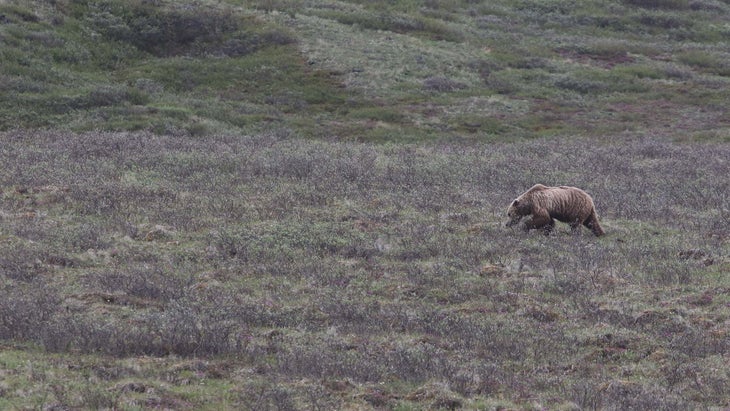Products You May Like
They could’ve been small patches of snow, remnants of an Arctic winter clinging to the North Slope of the Brooks Range in the Arctic National Wildlife Refuge (ANWR).Instead, it was a herd of 18 nimble Dall sheep, megafauna teeming in North America’s largest wildlife refuge at 19.3 million acres.
Rafting along the steady flow of the Kongakut River, I scanned the sweeping topography with my binoculars for the snow-white herbivores. Browsing on a mountain face smothered in peat, permafrost, hillocks and tundra wildflowers, the Dall sheep nimbly traversed up into the lichen-covered limestone cliffs towering above the braided Kongakut.
After tracking that herd for two miles, I finally found myself approximately 100 feet across from the Dall sheep on my own limestone perch. However, I wasn’t alone. Apparently, I had overstepped my bounds, and two Arctic ground squirrels were letting me know about it. They defiantly chirped at me, scuffed at the loose scree, then vanished into their maze of burrows.

Rivers on the North Slope of the Brooks Range flow northward into the vast Coastal Plain of the refuge, a 1.5-million-acre stretch fortified by gritty barrier islands, the Beaufort Sea, and the Arctic Ocean. The Plain is the calving ground for the 130,000-strong Porcupine caribou herd, which breeds in western Canada before coming here to calve, making the longest migration of any terrestrial mammal on the planet.
The refuge is home to 250 bird species, and includes vital habitat for thousands of nesting shorebirds like red-necked phalaropes, least terns, and dunlin. During harsh Arctic winters, ANWR provides important denning sites for polar bears. Among the 43 species of mammals, musk ox, gray wolves, grizzly bears, Arctic and red foxes and wolverines also thrive in this remote swath of Alaska. The area includes the native lands of the Inupiat in the north and the Gwich’in in the southeast, both of whom have lived here since long before the U.S. declared it a national wildlife refuge in 1960.

Unfortunately, ANWR is home to more than animals and human communities. Since 1977, the refuged has been on a political rollercoaster, dodging advances by oil and gas companies eager to tap into its potential oil reserves. Estimates range from 7.7 to 11.8 billion barrels of oil beneath the permafrost on the Coastal Plain, also known as “1002 Area”. Due to political pressure, the federal government left the Coastal Plain unprotected when it created the refuge. Since 1986, Congress has introduced several bills to protect the fragile expanse of the Coastal Plain. Should oil and gas exploration become the norm here, it could be catastrophic for the Porcupine herd, and potentially the people who rely on them.
The rollercoaster continues today. Under the Trump administration, a provision in the 2017 federal tax bill made oil and gas exploration in ANWR the law. But when leases went to auction on January 6, 2020, the bids fell far short of their expected value of $900 million. About half the region received no offers at all; two smaller companies each secured a lease totaling $14 million in revenue. Not one major oil company submitted a bid.While many Alaskan politicians continue to argue drilling would be good for jobs, the economy and state revenue, the results of the auction seemed to conflict with their predictions.

Then, on his very first day in office, President Joe Biden put a temporary halt to oil and gas drilling in the roadless expanse of ANWR.
“NRDC, alongside critical partners among Indigenous peoples and conservation groups, has drawn a line with the Arctic Refuge, and the Biden-Harris Administration understands the stakes,” said Garrett Rose, staff attorney with Natural Resources Defense Council’s Alaska Project. “This is America’s last, best place. If we can’t safeguard the Refuge from extractive industry, then no place in America is safe.”
Currently, the two small oil companies that did secure leases on the Coastal Plain, Regenerate Alaska, a subsidiary of Australia-based 88 Energy, and Knik Arm Services, a small Alaska company managed by an investor named Mark Graber, have rolled back their efforts to move forward with oil exploration. The costs of building roads, helipads and other infrastructure on the Coastal Plain has apparently far outweighed the benefit. For now, the Arctic National Wildlife Refuge is safe. For locals who had opposed drilling, it was cause to celebrate.
“It is so important that our young people see that we are heard, and that the president acknowledges our voices, our human rights and our identity,” Bernadette Demientieff, executive director of the Gwich’in Steering Committee, said in a statement.

Rafting down the Kongakut against a stiff northerly headwind, we found ourselves running alongside a large, blonde male grizzly bear. Its head down and into the wind, the big boar sauntered along the foothills of the Brooks Range, foraging for food to help it bulk up for the coming cold.
We pitched camp a few miles further downriver. As I put up my tent, I scanned for the bear, which I anticipated had kept heading north. Sure enough, the 800-pound grizzly soon appeared on the horizon; through my binoculars, I caught it bedding down on the tundra.
Optics in hand, I decided to get a little closer. I bushwhacked on foot through the willows, working my way downwind and south of the slumbering grizzly. Light rain fell as dark clouds swirled above the high peaks of the Brooks Range. Soddened by the rain, the grizzly occasionally rolled, yawned, and stretched its legs on its spongy bed of peat moss as I took my position in the brush about 150 yards away. For a brief moment, the tundra and the bear lying on it were utterly calm
Then, without warning, the grizzly awoke, got to its feet, and resumed trudging northward into the next river veld. As I watched the grizzly crest the horizon, the enormity of the ANWR—the largest, last great place in the north—almost made it seem small.
